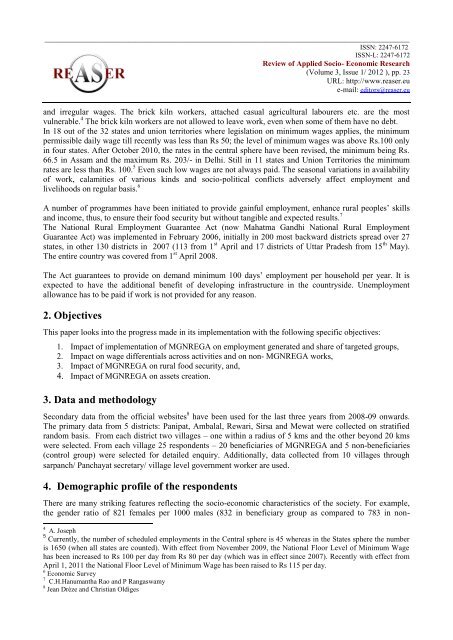Volume 3, ISSUE1/2012 - Review of Applied Socio-Economic ...
Volume 3, ISSUE1/2012 - Review of Applied Socio-Economic ...
Volume 3, ISSUE1/2012 - Review of Applied Socio-Economic ...
Create successful ePaper yourself
Turn your PDF publications into a flip-book with our unique Google optimized e-Paper software.
________________________________________________________________________________________________<br />
ISSN: 2247-6172<br />
ISSN-L: 2247-6172<br />
<strong>Review</strong> <strong>of</strong> <strong>Applied</strong> <strong>Socio</strong>- <strong>Economic</strong> Research<br />
(<strong>Volume</strong> 3, Issue 1/ <strong>2012</strong> ), pp. 23<br />
URL: http://www.reaser.eu<br />
e-mail: editors@reaser.eu<br />
and irregular wages. The brick kiln workers, attached casual agricultural labourers etc. are the most<br />
vulnerable. 4 The brick kiln workers are not allowed to leave work, even when some <strong>of</strong> them have no debt.<br />
In 18 out <strong>of</strong> the 32 states and union territories where legislation on minimum wages applies, the minimum<br />
permissible daily wage till recently was less than Rs 50; the level <strong>of</strong> minimum wages was above Rs.100 only<br />
in four states. After October 2010, the rates in the central sphere have been revised, the minimum being Rs.<br />
66.5 in Assam and the maximum Rs. 203/- in Delhi. Still in 11 states and Union Territories the minimum<br />
rates are less than Rs. 100. 5 Even such low wages are not always paid. The seasonal variations in availability<br />
<strong>of</strong> work, calamities <strong>of</strong> various kinds and socio-political conflicts adversely affect employment and<br />
livelihoods on regular basis. 6<br />
A number <strong>of</strong> programmes have been initiated to provide gainful employment, enhance rural peoples’ skills<br />
and income, thus, to ensure their food security but without tangible and expected results. 7<br />
The National Rural Employment Guarantee Act (now Mahatma Gandhi National Rural Employment<br />
Guarantee Act) was implemented in February 2006, initially in 200 most backward districts spread over 27<br />
states, in other 130 districts in 2007 (113 from 1 st April and 17 districts <strong>of</strong> Uttar Pradesh from 15 th May).<br />
The entire country was covered from 1 st April 2008.<br />
The Act guarantees to provide on demand minimum 100 days’ employment per household per year. It is<br />
expected to have the additional benefit <strong>of</strong> developing infrastructure in the countryside. Unemployment<br />
allowance has to be paid if work is not provided for any reason.<br />
2. Objectives<br />
This paper looks into the progress made in its implementation with the following specific objectives:<br />
1. Impact <strong>of</strong> implementation <strong>of</strong> MGNREGA on employment generated and share <strong>of</strong> targeted groups,<br />
2. Impact on wage differentials across activities and on non- MGNREGA works,<br />
3. Impact <strong>of</strong> MGNREGA on rural food security, and,<br />
4. Impact <strong>of</strong> MGNREGA on assets creation.<br />
3. Data and methodology<br />
Secondary data from the <strong>of</strong>ficial websites 8 have been used for the last three years from 2008-09 onwards.<br />
The primary data from 5 districts: Panipat, Ambalal, Rewari, Sirsa and Mewat were collected on stratified<br />
random basis. From each district two villages – one within a radius <strong>of</strong> 5 kms and the other beyond 20 kms<br />
were selected. From each village 25 respondents – 20 beneficiaries <strong>of</strong> MGNREGA and 5 non-beneficiaries<br />
(control group) were selected for detailed enquiry. Additionally, data collected from 10 villages through<br />
sarpanch/ Panchayat secretary/ village level government worker are used.<br />
4. Demographic pr<strong>of</strong>ile <strong>of</strong> the respondents<br />
There are many striking features reflecting the socio-economic characteristics <strong>of</strong> the society. For example,<br />
the gender ratio <strong>of</strong> 821 females per 1000 males (832 in beneficiary group as compared to 783 in non-<br />
4 A. Joseph<br />
5 Currently, the number <strong>of</strong> scheduled employments in the Central sphere is 45 whereas in the States sphere the number<br />
is 1650 (when all states are counted). With effect from November 2009, the National Floor Level <strong>of</strong> Minimum Wage<br />
has been increased to Rs 100 per day from Rs 80 per day (which was in effect since 2007). Recently with effect from<br />
April 1, 2011 the National Floor Level <strong>of</strong> Minimum Wage has been raised to Rs 115 per day.<br />
6 <strong>Economic</strong> Survey<br />
7 C.H.Hanumantha Rao and P Rangaswamy<br />
8 Jean Drèze and Christian Oldiges








